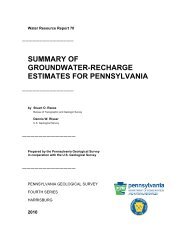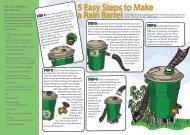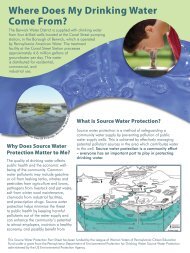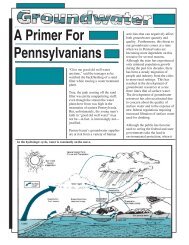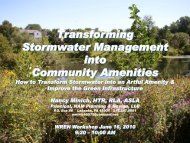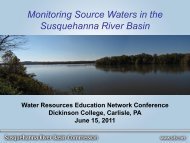NITROGEN POLLUTION: - Hubbard Brook Research Foundation
NITROGEN POLLUTION: - Hubbard Brook Research Foundation
NITROGEN POLLUTION: - Hubbard Brook Research Foundation
Create successful ePaper yourself
Turn your PDF publications into a flip-book with our unique Google optimized e-Paper software.
<strong>NITROGEN</strong> TRENDS IN PRECIPITATION<br />
HUBBARD BROOK EXPERIMENTAL FOREST, NH<br />
40<br />
N in bulk deposition<br />
(microequivalents per liter)<br />
35<br />
20<br />
10<br />
nitrate<br />
ammonium<br />
0<br />
1960 1965 1970 1975 1980 1985 1990 1995<br />
Year<br />
Long-term data from the <strong>Hubbard</strong> <strong>Brook</strong> Ecosystem Study show that the<br />
concentration of nitrogen in precipitation has been relatively constant since<br />
measurements began there in the early 1960s (see Figure 9). These relatively high<br />
deposition levels persist in part because the 1990 Amendments to the Clean Air<br />
Act (CAAAs) did not substantially limit nitrogen emissions.<br />
l Nitrogen in fertilizer (11-32 percent)<br />
Nitrogen fertilizer is used throughout the region to increase crop yields and<br />
improve lawn and turf conditions. Based on fertilizer sales data, nitrogen fertilizer is<br />
the second or third largest source of reactive nitrogen in each of the eight Northeast<br />
watersheds analyzed. Of land in the Northeast likely to be fertilized, 60 percent is<br />
pasture and hay, 34 percent is row crops, 5 percent is urban recreational grasses and<br />
1 percent is “other.” The watershed with the highest annual input of nitrogen from<br />
fertilizer per land area is the Hudson River watershed in New York. The lowest levels<br />
are found in the Great Bay watershed in New Hampshire. The sale of nitrogen<br />
fertilizer in the region increased approximately 30 percent between 1965 and 2001.<br />
The use of nitrogen fertilizer on residential lawns is a growing component of fertilizer<br />
use in the U.S.<br />
There is a wide range in fertilizer application rates across the region. However,<br />
more nitrogen is generally applied to the land than can be assimilated by the<br />
vegetation. Some scientists estimate that approximately 20 percent of the nitrogen<br />
in fertilizer leaches to surface or ground waters, with extreme levels reaching as high<br />
as 80 percent for row crops in sandy soils (Howarth et al. 2002).<br />
l Nitrogen in animal feed (1-10 percent)<br />
Animal feed in the form of corn silage, oats and hay is imported to the Northeast<br />
to feed cows, pigs, chickens and other livestock. The watershed with the largest<br />
amount of nitrogen in animal feed per hectare is the Connecticut River watershed due<br />
to relatively high levels of livestock production. Nitrogen in animal feed can become<br />
a pollution source through the excretion of nitrogen-rich manure that releases<br />
gaseous ammonia into the atmosphere and leaches nitrate into local water bodies.<br />
Nitrogen in animal feed is of greatest concern on farms where intensive livestock<br />
production results in more nitrogen-rich manure than the farmer can effectively use<br />
as fertilizer, and where adequate containment or treatment facilities do not exist to<br />
minimize leaching to adjacent surface waters.<br />
n<br />
FIGURE 9:<br />
Trends in nitrate<br />
and ammonium in<br />
precipitation. From<br />
Likens and Bormann<br />
1995.<br />
PAGE 10



